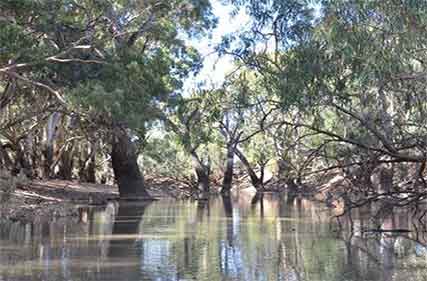
The NSW Government invites southern inland residents from Walbundrie to Moulamein and the lower reaches of Yanco Creek to have their say on key elements of the draft Billabong Creek Floodplain Management Plan, an important tool to manage rural flood works and their valley-wide effects on flows and connectivity.
Floodplain management plans set the rules for flood work applications within declared floodplains. Flood works include roads, channels, dams or levee banks that can change the way water flows to or from a river or change the way water moves during a flood.
Once developed, the Billabong Creek Floodplain Management Plan will be used as a guide to coordinate what types of flood works can be constructed and where. It will do this while balancing the needs of communities, landholders and the environment, and protecting cultural and heritage sites.
In this first round of public consultation, open until 18 November, we are inviting the community to give feedback on key elements that will inform the development of the draft plan.
These include the proposed floodplain boundary, the historical flood events used for modelling, cultural and heritage sites, ecological assets, and local variances to some rules, such as the maximum height for access roads.
It also includes the proposed floodway network (areas with high flow and areas important for the temporary storage of water).
We encourage residents and stakeholders to read the Report to Assist Public Consultation and book an appointment with department staff to ask questions and learn how to make a submission.
Starting the week of 21 October, we will host face-to-face appointments in Jerilderie, Moulamein and Wanganella, as well as online.
For more information and to book an appointment, visit: https://water.dpie.nsw.gov.au/our-work/floodplain-management/plans/valleys/billabong-creek-floodplain
We will release the full draft Billabong Creek Floodplain Management Plan as part of a second round of public consultation early next year.
The Department is delivering multiple programs across the region. While they do not operate in isolation, it’s important to note that consultation on the Billabong Creek Floodplain Management Plan is unrelated to the Department’s Reconnecting River Country Program which is focused on removing constraints to enable more flexible use of water for the environment.
For more information on the Reconnecting River Country Program, visit: https://www.dpie.nsw.gov.au/water/our-work/water-infrastructure-nsw/sdlam/reconnecting-river-country-program
NSW DCCEEW Executive Director of Water Planning, Giselle Howard, said the way we manage our floodplains is essential to protecting communities and supporting healthy environments, and the Billabong Creek floodplain is no exception.
“We know the Riverina was severely impacted by extreme flooding in 2022, which is another reminder why getting this plan right is more important than ever. It will put us in the best possible position to manage future risks and challenges.
“We’re inviting the entire community to learn more about this vital work and give us their feedback on key elements, which will be critical to developing a plan that works well for the entire Billabong Creek floodplain.
“Our staff will be out on the ground holding face-to-face appointments in Moulamein, Wanganella and Jerilderie, or you can book an appointment online.
“It’s important to have your say now as when the plan is complete and finalised it will be locked in for 10 years, so now is the time to share your views.”
